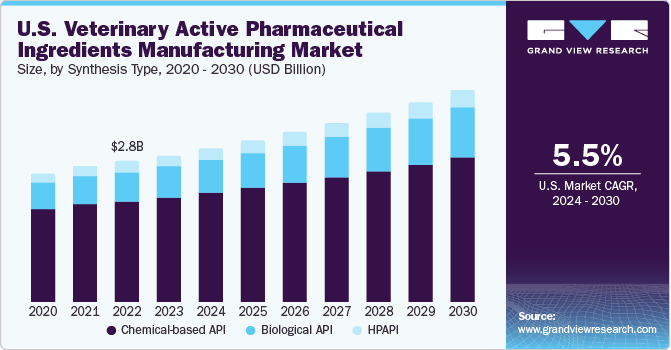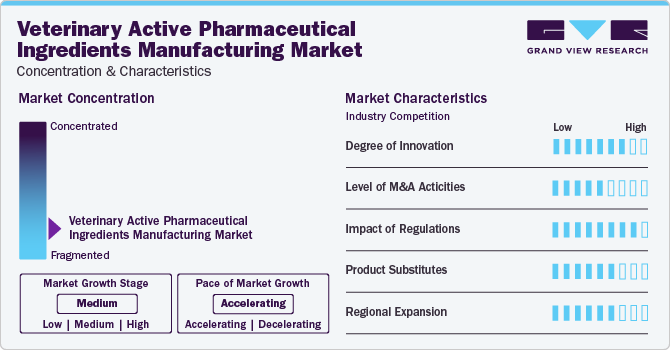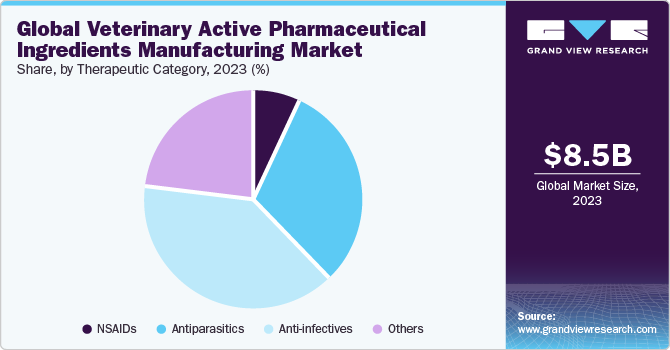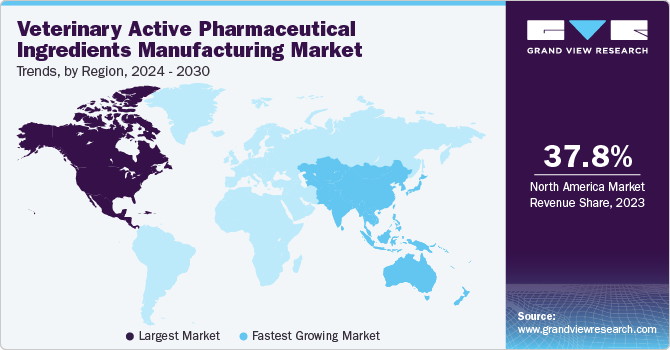- Home
- »
- Animal Health
- »
-
Veterinary Active Pharmaceutical Ingredients Manufacturing Market Report, 2030GVR Report cover
![Veterinary Active Pharmaceutical Ingredients Manufacturing Market Size, Share & Trends Report]()
Veterinary Active Pharmaceutical Ingredients Manufacturing Market Size, Share & Trends Analysis Report By Animal Type (Production, Companion), By Service Type, By Synthesis Type, By Therapeutic Category, And Segment Forecasts, 2024 - 2030
- Report ID: GVR-4-68039-328-0
- Number of Report Pages: 150
- Format: PDF, Horizon Databook
- Historical Range: 2018 - 2022
- Forecast Period: 2024 - 2030
- Industry: Healthcare
Market Size & Trends
The global veterinary active pharmaceutical ingredients manufacturing market size was estimated at USD 8.54 billion in 2023 and is projected to grow at a compound annual growth rate (CAGR) of 6.8% from 2024 to 2030. Key factors driving market growth include rising investments in outsourcing, facility expansion, R&D of new veterinary products, and expenditure on animal health. In January 2023, Merck & Co., Inc.’s animal health division expanded its manufacturing facility in the Netherlands for pet vaccine production. The location is part of Merck’s manufacturing network in the country, comprising existing production and research facilities in Boxmeer and De Bilt in the veterinary vaccine market.

Cost efficiency and operational benefits drive market growth. Animal health companies increasingly seek ways to optimize their operations and enhance cost-effectiveness. Outsourcing the manufacturing of veterinary APIs allows pharmaceutical companies to focus on their core competencies, such as research & development, marketing, and distribution. By entrusting API production to specialized manufacturers, companies can streamline operations and allocate resources more efficiently. Zoetis, a leading animal health company operated 29 manufacturing sites in 2022. Moreover, the company has collaborated with 132 CMOs supporting its global product manufacturing and supply chain.
Outsourcing allows companies to leverage cost competitiveness by selecting manufacturing partners in regions with favorable economic conditions. This can result in cost savings without compromising the product quality and contributing to overall competitiveness in the global market. Moreover, this helps mitigate risks associated with market uncertainties, regulatory changes, and fluctuations in demand. By partnering with experienced CMOs, companies can share risks and responsibilities, allowing them to adapt more quickly to changes in the business environment.
Market Concentration & Characteristics
The market is fragmented and exhibits diverse participants, including large pharmaceutical companies, contract manufacturing organizations (CMOs), and smaller niche players. This diversity contributes to varied expertise, specialization, and product offerings. Large multinational corporations with a global reach hold a significant market share due to their extensive resources, diverse portfolios, and the ability to serve multiple markets. These companies influence market trends and competition. However, only some companies aim to focus on API production excelling in certain therapeutic areas for catering to specific species.

The market growth stage is medium, and its pace is accelerating. Rapid technological advancements, investments in R&D, and regulatory support and compliance influence the pace of market growth. This acceleration can lead to quicker development and production of veterinary APIs. Moreover, the market is witnessing increased innovation in terms of new therapeutic approaches, drug delivery systems, and preventive healthcare solutions. Companies are also expanding their production capacities to meet the rising demand for veterinary APIs.
Companies allocate substantial resources to R&D, leading to continuous innovation in the development and production of pharmaceutical ingredients. This investment supports the exploration of novel therapeutic approaches, molecules, and manufacturing technologies leading to a high degree of innovation.
Merger & acquisition (M&A) activities serve as strategic responses to evolving market dynamics, regulatory changes, and emerging industry trends. Companies engage in M&A to position themselves strategically, diversify their portfolio, and stay ahead of competitive challenges. The market experiences a notable level of consolidation through mergers and acquisitions. Larger companies acquire smaller ones to consolidate market share, expand product portfolios, and gain access to complementary capabilities.
The market is subject to stringent regulations governing the quality, safety, and efficacy of pharmaceutical products and vaccines for animals. Regulatory authorities set standards to ensure veterinary APIs meet specific criteria, reflecting a commitment to animal health and welfare. The approval processes for veterinary APIs involve rigorous testing, documentation, and adherence to Good Manufacturing Practices (GMP) standards. Achieving and maintaining compliance can be resource-intensive and time-consuming.
Also, while product substitutes exist, the market includes niche areas and specialized products where direct substitutes are less prevalent. Companies focusing on specific therapeutic areas or unique formulations experience lower substitution pressures. High regional expansion indicates companies strategically establishing their operations in multiple regions to tap into diverse markets and capitalize on emerging opportunities.
Synthesis Type Insights
The chemical-based API segment dominated the market with a share of about 71.3% in 2023. This segment comprises synthetic chemical APIs excluding HPAPIs. High demand and uptake of chemical-based APIs along with their finished products are the key drivers for this segment’s growth. As per Boehringer Ingelheim International GmbH and internal GVR estimates, Boehringer’s NexGard product line comprising Afoxolaner and Milbemycin Oxime active ingredients brought in an estimated revenue of USD 1.2 billion in 2022.
The biological API segment is anticipated to grow at the fastest CAGR of 8.3% from 2024 to 2030. This is due to advancements in biotechnology, innovations in vaccine development, investments in production capacity expansion, and initiatives by key companies. In October 2021, for instance, Zoetis expanded its manufacturing and development facility in Tullamore, Ireland. This has significantly increased its capacity for producing veterinary monoclonal antibodies (mAbs) in response to commercial demand and the pipeline of future mAbs.
Animal Type Insights
The production animals segment attributed to the largest market share of 59.4 % in 2023 in terms of animal type. This is due to the growing consumption of meat, milk, and dairy products, the need to safeguard food sources, and the presence of several companies in the sector. Vetpharma for instance, specializes in the development, registration, and marketing of veterinary APIs for both production and companion animals. APIs are essential in preventing and controlling various diseases that affect animals. Vaccines, antibiotics, and other pharmaceuticals contribute to maintaining the health and well-being of livestock, thereby ensuring a stable and productive supply chain.
The companion animals segment is projected to grow at the fastest growth rate from 2024 to 2030. This is due to increasing pet expenditure & pet humanization, rising raging pet population, innovation in companion animal medicine, and uptake of pet insurance. Akston Biosciences Corporation, for example, is one such company involved in the development and manufacturing of breakthrough protein therapeutics for pets. This company has partnered with Dechra to discover and develop API candidates for canine and feline diabetes using its Ambifect Fc-fusion protein platform.
Service Type Insights
The in-house segment held the highest market share of 62.3% in 2023. In-house manufacturing allows pharmaceutical companies to have direct control over the entire production process. This control is crucial for maintaining and ensuring the quality of APIs. Also, developing proprietary formulations and manufacturing processes allows companies to protect their intellectual property. In-house manufacturing helps safeguard the unique aspects of pharmaceutical products, such as novel API compositions or innovative production methods, thus contributing to the high share of the segment.
The contract outsourcing segment is projected to grow at the fastest CAGR from 2024 to 2030. Companies from key markets, such as the U.S., outsource API manufacturing and raw material procurement to countries, such as China and India. Moreover, outsourcing enables pharmaceutical companies to concentrate on their core competencies, such as R&D, marketing, and distribution, while leaving the manufacturing of APIs to specialized outsourcing partners. All these factors support the growth of the contract outsourcing segment.
Therapeutic Category Insights
The anti-infective segment held the highest share of 39.1% in 2023. The segment’s dominance can be attributed to factors related to the critical role of anti-infective agents in ensuring the health and well-being of animals. Anti-infectives, including antibiotics, antivirals, and antifungals are crucial for preventing and treating a variety of diseases in animals. The increasing prevalence of these diseases in animals necessitates a continuous supply of anti-infective APIs.

The others segment, comprising oncology, diabetes, and other drugs, is estimated to grow at the fastest CAGR from 2024 to 2030. This is due to increased awareness and improved diagnostic capabilities in veterinary medicine, leading to the identification and treatment of conditions, such as cancer and diabetes, in animals. Greater awareness among pet owners and veterinarians about these diseases is estimated to drive the demand for pharmaceuticals, including APIs. Moreover, an aging pet population contributes to a higher incidence of chronic conditions in animals. This is anticipated to propel market growth.
Regional Insights
North America accounted for the largest share of 37.8% of the market in 2023. Key factors contributing to this significant share include the strong local presence of major animal healthcare companies, high pet ownership rates, advanced veterinary healthcare infrastructure, and growing R&D in veterinary healthcare. Several major pharmaceutical companies such as Zoetis and Elanco with a focus on veterinary medicine have their headquarters or significant operations in the U.S. These companies play a vital role in driving the development and manufacturing of veterinary APIs.

Asia Pacific on the other hand is anticipated to grow the fastest at a CAGR of about 7.9% from 2024 to 2030. This is due to the growing health concerns about animals, increasing adoption of pet animals, high livestock population, growing disposable income & veterinary expenditure, and rising number of veterinary API production units. The significant number of companion animals and increasing outsourcing by animal health companies has led to a substantial demand for veterinary pharmaceuticals, including APIs.
Key Veterinary Active Pharmaceutical Ingredients Manufacturing Company Insights
The veterinary API manufacturing market is characterized by a diverse range of companies, including large multinational pharmaceutical corporations, mid-sized enterprises, and smaller niche players. This diversity reflects the broad spectrum of APIs required for veterinary pharmaceuticals, addressing the varied health needs of different animal species. Large companies often have diverse portfolios that include APIs for both human and veterinary use. Their global reach allows them to serve a wide range of markets. Alongside major pharmaceutical companies, there are specialized contract manufacturing organizations (CMOs) focusing on the human and animal health sector or exclusively on veterinary API production.
These organizations are engaged in deploying various strategic initiatives to increase their market share. For instance, to maintain a competitive edge, companies often expand regionally to position themselves strategically against competitors. Establishing a strong presence in multiple regions allows companies to capture a higher market share, leverage economies of scale, and adapt to regional market dynamics. Collaborations and partnerships between pharmaceutical companies and contract manufacturers are common in this industry. Such alliances enable companies to leverage the expertise and capabilities of manufacturing partners while maintaining their focus on research, development, and commercialization.
Key Veterinary Active Pharmaceutical Ingredients Manufacturing Companies:
The following are the leading companies in the veterinary active pharmaceutical ingredients manufacturing market. These companies collectively hold the largest market share and dictate industry trends. Financials, strategy maps & products of these veterinary API manufacturing companies are analyzed to map the supply network.
- Zoetis
- Alivira Animal Health Ltd.
- Ofichem Group
- Chempro Pharma Pvt. Ltd.
- Siflon Drugs
- Qilu Animal Health Products Co., Ltd.
- Vetpharma
- SUANFARMA
- MENADIONA
- Excel Industries Ltd.
Recent Developments
-
In April 2022, Boehringer Ingelheim invested in the expansion of its facility in Georgia thereby extended its R&D capabilities in animal health among others
-
In October 2021, Zoetis invested in the expansion of its manufacturing and development facility in Ireland thus adding to its capabilities
-
In May 2021, Sentrx Animal Care inaugurated a new manufacturing facility in the U.S. This enabled the company to maintain complete control over the highly proprietary processes and quality for manufacturing its in-market formulations at commercial scale. It also ensured the company remained a vertically integrated manufacturing operation
Veterinary Active Pharmaceutical Ingredients Manufacturing Market Report Scope
Report Attribute
Details
Market size value in 2024
USD 9.0 billion
Revenue forecast in 2030
USD 13.47 billion
Growth rate
CAGR of 6.8% from 2024 to 2030
Base year for estimation
2023
Historical data
2018 - 2022
Forecast period
2024 - 2030
Report updated
January 2024
Quantitative units
Revenue in USD million/billion and CAGR from 2024 to 2030
Report coverage
Revenue forecast, company ranking, competitive landscape, growth factors, and trends
Segments covered
Service type, synthesis type, animal type, therapeutic category, region
Regional scope
North America; Europe; Asia Pacific; Latin America; MEA
Country scope
U.S.; Canada; UK; Germany; France; Italy; Spain; Denmark; Sweden; Norway; Japan; China; India; Australia; Thailand; South Korea; Brazil; Mexico; Argentina; South Africa; Saudi Arabia; UAE; Kuwait
Key companies profiled
Zoetis; Alivira Animal Health Limited; Ofichem Group; Chempro Pharma Private Limited; Siflon Drugs; Qilu Animal Health Products Co., Ltd.; Vetpharma; SUANFARMA; MENADIONA; Excel Industries Ltd.
Customization scope
Free report customization (equivalent up to 8 analysts working days) with purchase. Addition or alteration to country, regional & segment scope.
Pricing and purchase options
Avail customized purchase options to meet your exact research needs. Explore purchase options
Veterinary Active Pharmaceutical Ingredients Manufacturing Market Report Segmentation
This report forecasts revenue growth at global, regional, and country levels and provides an analysis of the latest trends in each of the sub-segments from 2018 to 2030. For this study, Grand View Research has segmented the veterinary active pharmaceutical ingredients manufacturing market report based on service type, synthesis type, animal type, therapeutic category, and region:
-
Service Type Outlook (Revenue in USD Million, 2018 - 2030)
-
In House
-
Contract Outsourcing
-
Contract Development
-
Preclinical Development
-
Clinical Development
-
Contract Manufacturing
-
-
-
Synthesis Type Outlook (Revenue in USD Million, 2018 - 2030)
-
Chemical-based API
-
Biological API
-
HPAPI
-
-
Animal Type Outlook (Revenue in USD Million, 2018 - 2030)
-
Production Animals
-
Companion Animals
-
-
Therapeutic Category Outlook (Revenue in USD Million, 2018 - 2030)
-
Antiparasitics
-
Anti-infectives
-
NSAIDs
-
Others
-
-
Regional Outlook (Revenue, USD Million, 2018 - 2030)
-
North America
-
U.S.
-
Canada
-
Mexico
-
-
Europe
-
Germany
-
UK
-
France
-
Italy
-
Spain
-
Denmark
-
Norway
-
Sweden
-
Rest of Europe
-
-
Asia Pacific
-
Japan
-
China
-
India
-
South Korea
-
Australia
-
Thailand
-
Rest of Asia Pacific
-
-
Latin America
-
Brazil
-
Argentina
-
Rest of Latin America
-
-
Middle East & Africa
-
South Africa
-
Saudi Arabia
-
Kuwait
-
UAE
-
Rest of MEA
-
-
Frequently Asked Questions About This Report
b. The global veterinary active pharmaceutical ingredients manufacturing market size was estimated at USD 8.54 billion in 2023 and is expected to reach USD 9.0 billion in 2024.
b. The global veterinary active pharmaceutical ingredients manufacturing market is expected to grow at a compound annual growth rate (CAGR) of 6.8% from 2024 to 2030 to reach USD 13.47 billion by 2030.
b. By region, North America attributed to the largest share of about 37% of the market in 2023. Key factors contributing to this significant share include the strong local presence of major animal healthcare companies, high pet ownership rates, advanced veterinary healthcare infrastructure, and growing R&D in veterinary healthcare.
b. Some key players operating in the veterinary API manufacturing market include Zoetis; Alivira Animal Health Limited; Ofichem Group; Chempro Pharma Private Limited; Siflon Drugs; Qilu Animal Health Products Co., Ltd.; Vetpharma; SUANFARMA; MENADIONA; Excel Industries Ltd.
b. Some of the key factors accounting for market growth include growing investments in outsourcing, facility expansion, R&D of new veterinary products and expenditure on animal health.
Share this report with your colleague or friend.
![gvr icn]()
NEED A CUSTOM REPORT?
We can customize every report - free of charge - including purchasing stand-alone sections or country-level reports, as well as offer affordable discounts for start-ups & universities. Contact us now
![Certified Icon]()
We are GDPR and CCPA compliant! Your transaction & personal information is safe and secure. For more details, please read our privacy policy.
We are committed towards customer satisfaction, and quality service.
"The quality of research they have done for us has been excellent."





